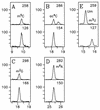Posttranscriptional modifications in 16S and 23S rRNAs of the archaeal hyperthermophile Sulfolobus solfataricus
- PMID: 9603876
- PMCID: PMC107253
- DOI: 10.1128/JB.180.11.2883-2888.1998
Posttranscriptional modifications in 16S and 23S rRNAs of the archaeal hyperthermophile Sulfolobus solfataricus
Abstract
Posttranscriptional modification is common to many types of RNA, but the majority of information concerning structure and function of modification is derived principally from tRNA. By contrast, less is known about modification in rRNA in spite of accumulating evidence for its direct participation in translation. The structural identities and approximate molar levels of modifications have been established for 16S and 23S rRNAs of the archaeal hyperthermophile Sulfolobus solfactaricus by using combined chromatography-mass spectrometry-based methods. Modification levels are exceptionally high for prokaryotic organisms, with approximately 38 modified sites in 16S rRNA and 50 in 23S rRNA for cells cultured at 75 degrees C, compared with 11 and 23 sites, respectively, in Escherichia coli. We structurally characterized 10 different modified nucleosides in 16S rRNA, 64% (24 residues) of which are methylated at O-2' of ribose, and 8 modified species in 23S rRNA, 86% (43 residues) of which are ribose methylated, a form of modification shown in earlier studies to enhance stability of the polynucleotide chain. From cultures grown at progressively higher temperatures, 60, 75, and 83 degrees C, a slight trend toward increased ribose methylation levels was observed, with greatest net changes over the 23 degrees C range shown for 2'-O-methyladenosine in 16S rRNA (21% increase) and for 2'-O-methylcytidine (24%) and 2'-O-methylguanosine (22%) in 23S rRNA. These findings are discussed in terms of the potential role of modification in stabilization of rRNA in the thermal environment.
Figures



Similar articles
-
Separate pathways for excision and processing of 16S and 23S rRNA from the primary rRNA operon transcript from the hyperthermophilic archaebacterium Sulfolobus acidocaldarius: similarities to eukaryotic rRNA processing.Mol Microbiol. 1994 Jul;13(2):229-42. doi: 10.1111/j.1365-2958.1994.tb00418.x. Mol Microbiol. 1994. PMID: 7527119
-
RNomics in Archaea reveals a further link between splicing of archaeal introns and rRNA processing.Nucleic Acids Res. 2002 Feb 15;30(4):921-30. doi: 10.1093/nar/30.4.921. Nucleic Acids Res. 2002. PMID: 11842103 Free PMC article.
-
Influence of phylogeny on posttranscriptional modification of rRNA in thermophilic prokaryotes: the complete modification map of 16S rRNA of Thermus thermophilus.Biochemistry. 2006 Apr 18;45(15):4888-99. doi: 10.1021/bi052579p. Biochemistry. 2006. PMID: 16605256
-
Expanding the nucleotide repertoire of the ribosome with post-transcriptional modifications.ACS Chem Biol. 2007 Sep 21;2(9):610-9. doi: 10.1021/cb7001494. ACS Chem Biol. 2007. PMID: 17894445 Free PMC article. Review.
-
Synthesis, Function, and Heterogeneity of snoRNA-Guided Posttranscriptional Nucleoside Modifications in Eukaryotic Ribosomal RNAs.Enzymes. 2017;41:169-213. doi: 10.1016/bs.enz.2017.03.007. Epub 2017 Apr 24. Enzymes. 2017. PMID: 28601222 Review.
Cited by
-
Structural basis of successive adenosine modifications by the conserved ribosomal methyltransferase KsgA.Nucleic Acids Res. 2021 Jun 21;49(11):6389-6398. doi: 10.1093/nar/gkab430. Nucleic Acids Res. 2021. PMID: 34086932 Free PMC article.
-
Recognition of a complex substrate by the KsgA/Dim1 family of enzymes has been conserved throughout evolution.RNA. 2006 May;12(5):725-33. doi: 10.1261/rna.2310406. Epub 2006 Mar 15. RNA. 2006. PMID: 16540698 Free PMC article.
-
Small nucleolar RNAs: versatile trans-acting molecules of ancient evolutionary origin.Gene Expr. 2002;10(1-2):17-39. Gene Expr. 2002. PMID: 11868985 Free PMC article. Review.
-
Number, position, and significance of the pseudouridines in the large subunit ribosomal RNA of Haloarcula marismortui and Deinococcus radiodurans.RNA. 2005 Feb;11(2):210-9. doi: 10.1261/rna.7209905. RNA. 2005. PMID: 15659360 Free PMC article.
-
Genetic evidence for 18S rRNA binding and an Rps19p assembly function of yeast nucleolar protein Nep1p.Mol Genet Genomics. 2006 Sep;276(3):273-84. doi: 10.1007/s00438-006-0132-x. Epub 2006 May 24. Mol Genet Genomics. 2006. PMID: 16721597
References
-
- Agris P F, Koh P, Söll D. The effect of growth temperature on the in vivo ribose methylation of Bacillus stearothermophilus. Arch Biochem Biophys. 1973;154:277–282. - PubMed
-
- Björk G, Ericson J U, Gustafsson C E D, Hagervall T G, Jönsson Y H, Wikström P M. Transfer RNA modification. Annu Rev Biochem. 1987;56:263–287. - PubMed
-
- Björk G. The role of modified nucleosides in tRNA interactions. In: Hatfield D L, Lee B J, Pirtle R M, editors. Transfer RNA in protein synthesis. Boca Raton, Fla: CRC Press; 1992. pp. 23–85.
-
- Brimacombe R, Mitchell P, Osswald M, Stade K, Bochkariov D. Clustering of modified nucleotides at the functional center of bacterial ribosomal RNA. FASEB J. 1993;7:161–167. - PubMed
Publication types
MeSH terms
Substances
Grants and funding
LinkOut - more resources
Full Text Sources
Other Literature Sources

